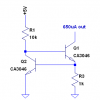Hi,
I am trying to simulate this circuit. The circuit is working well but for the current mirror made from two NPN. We consider Vbe = 0,7V for calculation. β=290. I want a current Iout of 675µA. When I simulate the circuit, I get my 675µA on the reference but my Iout is approximatively 840µA. I don't understand what is happening. I tried to simulate the current mirror only with a 300Ω load between collector of Q4 and ground but I seem to get the same problem. Someone has an idea of what is not working?
Thanks!
I am trying to simulate this circuit. The circuit is working well but for the current mirror made from two NPN. We consider Vbe = 0,7V for calculation. β=290. I want a current Iout of 675µA. When I simulate the circuit, I get my 675µA on the reference but my Iout is approximatively 840µA. I don't understand what is happening. I tried to simulate the current mirror only with a 300Ω load between collector of Q4 and ground but I seem to get the same problem. Someone has an idea of what is not working?
Thanks!


